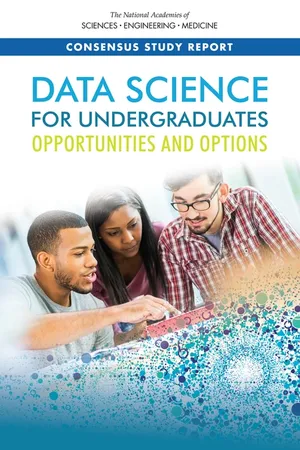
- English
- ePUB (mobile friendly)
- Available on iOS & Android
About this book
Data science is emerging as a field that is revolutionizing science and industries alike. Work across nearly all domains is becoming more data driven, affecting both the jobs that are available and the skills that are required. As more data and ways of analyzing them become available, more aspects of the economy, society, and daily life will become dependent on data. It is imperative that educators, administrators, and students begin today to consider how to best prepare for and keep pace with this data-driven era of tomorrow. Undergraduate teaching, in particular, offers a critical link in offering more data science exposure to students and expanding the supply of data science talent.Data Science for Undergraduates: Opportunities and Options offers a vision for the emerging discipline of data science at the undergraduate level. This report outlines some considerations and approaches for academic institutions and others in the broader data science communities to help guide the ongoing transformation of this field.
Frequently asked questions
- Essential is ideal for learners and professionals who enjoy exploring a wide range of subjects. Access the Essential Library with 800,000+ trusted titles and best-sellers across business, personal growth, and the humanities. Includes unlimited reading time and Standard Read Aloud voice.
- Complete: Perfect for advanced learners and researchers needing full, unrestricted access. Unlock 1.4M+ books across hundreds of subjects, including academic and specialized titles. The Complete Plan also includes advanced features like Premium Read Aloud and Research Assistant.
Please note we cannot support devices running on iOS 13 and Android 7 or earlier. Learn more about using the app.
Information
Table of contents
- COVER PAGE
- TITLE PAGE
- COPYRIGHT PAGE
- TABLE OF CONTENTS
- SUMMARY
- 1 INTRODUCTION
- 2 KNOWLEDGE FOR DATA SCIENTISTS
- 3 DATA SCIENCE EDUCATION
- 4 STARTING A DATA SCIENCE PROGRAM
- 5 EVOLUTION AND EVALUATION
- 6 CONCLUSIONS
- APPENDIXES